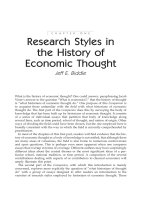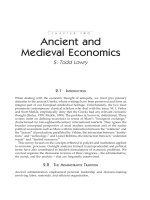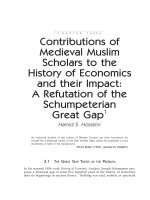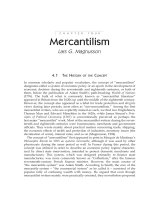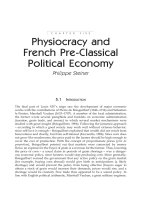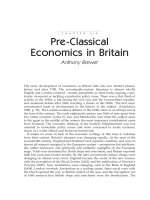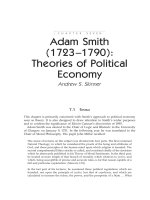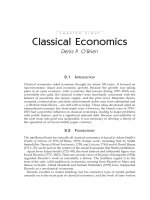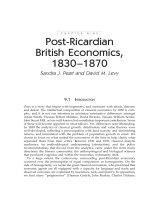A Companion to the History of Economic Thought - Chapter 37 ppt
Bạn đang xem bản rút gọn của tài liệu. Xem và tải ngay bản đầy đủ của tài liệu tại đây (158.85 KB, 12 trang )
622 J. L. CARDOSO
CHAPTER THIRTY- SEVEN
The International
Diffusion of
Economic Thought
José Luís Cardoso
37.1 THE HISTORIOGRAPHIC LEGACY
Nowadays, any mention of the problem of the international diffusion of eco-
nomic thought would seem to dispense with the need for justification or explana-
tion. Indeed, the very conditions and forms under which economic knowledge is
produced and circulated inevitably imply processes of creation and sharing in
which geographical and language barriers have been progressively eliminated.
The standardized levels of conceptual formalization and the almost unanimous
acceptance of similar techniques and instruments of analysis have made a deci-
sive contribution toward the formation of universal languages with a high poten-
tial for international communication. Above all, attention needs to be drawn to
the ease with which new research avenues and hypotheses are transmitted and
disseminated, together with new experiments and results, and new knowledge
about economic reality.
There is nothing original in claiming that the international transmission of
economic thought is a normal and recurrent phenomenon. Almost half a century
ago, this diagnosis was presented by T. W. Hutchison:
With the vastly increased number of translations and of widely circulating specialist
journals, including international journals, and with the increasingly mathematical
character of advanced economic analysis, it seems, on the whole, very unlikely that
good new ideas, whenever or wherever they do arise, will not have a reasonably fair
chance of being heard and of making their way . . . Economists are now part, even
THE INTERNATIONAL DIFFUSION OF ECONOMIC THOUGHT 623
often from their undergraduate years, of large, organised, internationally-linked aca-
demic machines, with their subjects closely organised and defined and their questions
and categories ready formulated. (1955, pp. 14–15)
If we consider the dramatic growth in communication instruments at the dis-
posal of the academic community over the past half-century, Hutchison’s words
would appear to be somewhat self-evident.
This does not mean that the problem should not be mentioned or is no longer
worthy of discussion. Even if the international diffusion of economic thought
may be seen today as relatively unproblematic, this has not always been the case.
The processes of and barriers to the international diffusion, transmission, and
appropriation that took place in the past have to a great extent contributed to
shaping and structuring the development of economic thought in ways that are
worth trying to understand.
To overcome any remaining skepticism about the relevance of such an endeavor,
it is sufficient to bear in mind the vast range of topics associated with the expres-
sion “economic thought.” In fact, this term embraces matters relating not only
to the ideological, doctrinal, or normative frameworks within which economic
thinkers operate, but also to the methods, concepts, and techniques of analysis
that they use, as well as to the implications of their theories in the definition of
economic policy guidelines. In other words, the subjects being studied show that
economics as a field of scientific inquiry is not immune to presuppositions based
on value judgments; nor is it in any way unaffected by the applications and uses
to which it is inevitably put. These are already more than enough reasons to
explain both the historical dimension of the subject and the added importance
of the process involved in the international transmission of economic thought,
inasmuch as it allows for a strengthening of the already close link between the
formation and diffusion of economics and the social environments and contexts
that give rise to its use and appropriation.
This is a subject that has generally been discussed without any visible antagon-
isms. In fact, it is even possible to note a certain consensus of interpretation that
has allowed authors with quite distinct views on economic science and its history
to converge in their approaches.
Given the importance of the Wealth of Nations for the foundation and shaping of
political economy as an autonomous field of scientific inquiry, it is only natural
that the diffusion of Smith’s work has been one of the earliest case studies that
brought to light a certain concern with the issue of the international transmission
of economic doctrines and theories. The limited impact of Smithian principles
of laissez faire in Germany at the end of the eighteenth century – as well as the
discussion of the meaning of some of the Smithian concepts concerning value
and distribution by his contemporary German translators and reviewers – was
the main topic of a pioneering essay by C. W. Hasek (1925). A few years later, the
subject was enriched with an overall picture of the theme (Palyi, 1928), providing
examples from several European countries and showing how Smithian influences
went hand in hand with other simultaneous influences, such as French physiocracy
and German cameralism.
624 J. L. CARDOSO
In spite of the innovative, groundbreaking nature of these essays, the question
of the international diffusion of economic thought only gained particular visibility
with the organization of a session devoted to this very theme at the Annual
Conference of the American Economic Association in 1954. The contributions to
this session, later published in the special Papers and Proceedings issue of the
American Economic Review in 1955, include the already mentioned paper by
T. W. Hutchison (1955), a text by Joseph Dorfman (1955), and a summary of the con-
ference discussion, with comments by J. Letiche, G. Hildebrand, and W. Jaffé.
Hutchison and Dorfman’s texts provide detailed analyses of research situations
that relate to specific periods and schools of economic thought. In Hutchison’s
case, his attention is concentrated on the genesis and diffusion of the theoretical
principles of the so-called marginalist revolution and neoclassical economics,
especially in regard to their Marshallian component. In Dorfman’s case, the subject
under analysis is the spread of the doctrinal principles of the German historical
school in the United States, laying emphasis on explaining the adaptations made
to some of the ideas imported, in order to make them better suited to addressing
the problems of American economic reality.
Regardless of the added value brought by these texts, which have made it
possible to look more deeply into new research subjects, they are also important
in terms of the minimum methodological framework that they seek to provide
for studying the phenomenon of the diffusion of economic ideas. More precisely,
they announce certain heuristic concerns about the formation, change, and succes-
sion of economic ideas, and about the favorable conditions, acceleration factors,
and obstacles that can hinder the processes that govern their subsequent trans-
mission and diffusion. Other aspects implicitly contained in the pioneering re-
flections of these texts are those that relate to the constraints dictated by different
levels of economic development and by the greater or lesser degree of cultural
and political cosmopolitanism, which, because they are inevitably found in any
society taken as the reference for such analysis, determine both the opportunity
for, and depth of, the diffusion processes.
Two authors who took a closer look at the methodological guidelines outlined
earlier deserve special mention. The first is Joseph J. Spengler, for his presenta-
tion of an embryonic information theory model (Spengler, 1970), in which the
author discusses the specific problems (arising whenever economic ideas are
being transmitted) that confront the source country, the receiver country, the
media of transmission, and the content transmitted.
The second author is Craufurd D. Goodwin, for two thorough contributions to
the discussion of the problem of the transfer of economic ideas. In one of these
papers (Goodwin, 1972), a general attempt is made to explain the relationship
between the spread of ideas and the prevailing social and political organization,
with a view to finding explanations for the diffusion of economic thought amongst
those different agents (professional economists, policy-makers, nonprofessional
public opinion) who use it for the development of social action. In another
text (Goodwin, 1973), after providing an overview of the main features of the
diffusion of marginalism in the English-speaking “New World” countries (Aus-
tralia, Canada, and the United States), Goodwin stresses the similarities and the
THE INTERNATIONAL DIFFUSION OF ECONOMIC THOUGHT 625
differences among the three major revolutions in economics (the Smithian,
marginal, and Keynesian revolutions) and their spread on a worldwide scale. He
argues that the differences concerning the technical content of economic theories,
and the links that these “scientific revolutions” had with economic policy issues,
social thought and philosophy, and the degree of development of the economics
profession, provide useful explanations to understand how economic ideas may
develop and mature in different environments. The focus on these topics is a
natural sequence to the case studies previously analyzed by the same author
(Goodwin, 1961, 1966, 1968).
A notable effort to systematize these subjects was made by Ernest Lluch (1980)
in a text which, because it was written in Spanish, ended up falling prey to one of
the very problems that he discusses in relation to the obstacles hindering the
transmission of innovative economic thought; that is, the lack of knowledge caused
by language barriers.
The main novelty introduced by Lluch’s text is the link that it establishes
between the analysis of international transmission and the definition of the
specificities of a national history of economic thought. In this type of approach,
the premise is maintained that cultural interchange at an international level is a
natural feature of everyday experience in both academic and professional life.
However, the smoothness of such an interchange may be subject to different
kinds of constraints.
One type of constraint relates to the development of the media of transmission,
such as the speed of circulation of foreign books, easy access to leading journals
in the field, overall familiarity with foreign languages, the quantity and quality
of translations, and facilities for private and institutional international contacts. It
also relates to the level of scientific autonomy or academic recognition that, in
given historical circumstances, economics may have attained in a certain country
or group of countries. It further relates to differences in economic development
between the source country and the receiver country, which may be more or less
apparent in different historical periods.
A second type of constraint is basically to be found in the existence of long-
lasting disequilibrium relationships between countries that have a tradition
of innovation and creation in economics and others that have no choice other
than to use and adapt a scientific discourse created abroad. One may be tempted
to assume that, in countries that have never been at the forefront of theoretical
developments, the history of economics is reduced to a mere succession of foreign
influences. But even if knowledge of, and familiarity with, what is done abroad is
a healthy sign of cosmopolitanism, it does not follow that the receiver country
has to accept the greater part of those ideas, analytic principles, and practical
recipes which only make sense in other historical settings. This means that the ease
or difficulty with which economic doctrines, theories, and policies are accepted
is always constrained by the particularities of the economic reality, social and
political institutions, and scientific environment in the receiver country. It is
precisely the way in which a country uses and adapts the influences received that
makes the study of the history of economic thought worthwhile from a national
point of view.
626 J. L. CARDOSO
This standpoint easily applies to the experience of many countries, for which
the distinctive features of a national thought stem from the complementary facets
of foreign influences and processes of original creation and adaptation. Examples
of this kind of approach are provided by Almodovar and Cardoso (1998), Boylan
and Foley (1992), Dasgupta (1993), Faccarello (1998), Groenewegen and MacFarlane
(1990), Morris-Suzuki (1989), Neill (1991), Quintana (1999–2001, vol. I), Sandelin
(1991), Sugiyama and Mizuta (1988), and Van Daal and Heertje (1992). According
to the available studies, nationality or place of residence or publication are criteria
regarded as necessary but not sufficient to determine the national character of
economic thought. Diffusion and reception are uneven and selective, in accord-
ance with the specific problems for which specific solutions are required; it is
when these problems are faced and solved that innovative, genuinely national
forms of economic thought may emerge. However, it should be noted that they
are still an outcome of international diffusion phenomena.
Returning once again to this brief historiographic review, it is now time to
mention another compulsory reference in establishing the general framework for
studying the processes involved in the diffusion of economic ideas. This is the
introduction of the book edited by David Colander and A. W. Coats (1989), in
which the authors present the major questions raised by the creation of general
models that explain the phenomenon under consideration here. Their approach
is based on three fundamental models: the infectious disease model, according to
which the spread of an idea can be likened to the spread of a disease; the informa-
tion theory model; and the model of the marketplace for ideas.
As far as the last model is concerned, one of the most notable aspects is the
way in which the authors implicitly adhere to the approach presented by George
J. Stigler (1983) for examining the reasons why, at a certain period, economic
ideas may be accepted, ignored, recycled, or rejected. In other words, it is a model
that subjects the process of transmission and appropriation to an approach iden-
tical to the one used for the study of any other type of market. The texts gathered
together by Colander and Coats, however, pay scant attention to the problem
of the international diffusion of economic ideas. Most attention is paid to the
processes of communication and diffusion between professional economists, and
between these and the public at large, as well as policy-makers.
Spengler’s information theory model was improved by Uskali Mäki (1996),
who provided an historiographic framework that explains a variety of aspects
related to the processes of transmission, selection, and adaptation of economic
ideas and their conditioning by different kinds of internal and external factors.
The methodological guidelines inspired by Stigler’s work with the model of
the market for ideas were further developed and coherently applied by Vicent
Llombart (1995) in a study of the critical reception afforded to physiocratic thought
in Spain.
37.2 SOME CASE STUDIES
Physiocracy is precisely one of the schools of economic thought that has been
studied more frequently from the perspective of the processes involved in its
THE INTERNATIONAL DIFFUSION OF ECONOMIC THOUGHT 627
international diffusion. This was, in fact, the subject underlying the organization
of a conference, whose papers were later published in Delmas, Demals, and
Steiner (1995), and whose original aim was a comparison of different countries in
relation to the specific question of the assimilation and critical use of the analytic,
doctrinal, and political legacy bequeathed to us by this school of economic thought.
The main conclusion arising from the contributions to this volume is that there
is a fundamental distinction to be made between countries that were receptive
to the theoretical features of physiocracy – namely the notions of produit net,
capital, and circular flow – and countries for which the diffusion of physiocratic
discourse was mainly conceived as a banner for a program of gradual reform of
ancien régime economic and social institutions. For the latter, the ideals of eco-
nomic liberalism inspired changes, but were primarily conceived as instruments
to reinforce social cohesion and were not meant to attack the established political
systems of enlightened despotism.
Since the publication of the above-mentioned pioneering essays on the diffusion
of Adam Smith across Europe (Hasek, 1925; Palyi, 1928), many other contribu-
tions have addressed the influences exerted by the author of the Wealth of Nations.
The books edited by H. Mizuta and C. Sugiyama (1993) and by Cheng-chung
Lai (2000) put together different sets of articles and chapters of books dealing
with the peculiarities of the motives for diffusion, the processes and speed of
reception and assimilation, the quality of translations, and the impact on decision-
makers in different countries, namely Germany, France, Italy, Spain, Portugal,
Denmark, Sweden, Russia, the United States, India, China, and Japan. A com-
plementary survey is also provided by the conference volume Smithian and
Neo-Smithian Political Economy (Béraud, Gislain, and Steiner, forthcoming).
When facing these different case studies, our main concern should be to find
patterns that allow us to establish parallels, divergences, and complementary rela-
tionships in the development of certain currents of economic thought in different
countries. This means that comparative studies are one of the most important
vehicles for analyzing the processes involved in the international diffusion and
assimilation of economic thought.
Such importance was clearly illustrated by the international project that cul-
minated in the conference held at San Miniato (Florence) in 1986, under the title
of “The Institutionalisation of Political Economy: Its Introduction and Acceptance
into European, American and Japanese Universities.” The main results of this
meeting were made known through a number of autonomous publications that
looked at experiences in the teaching and dissemination of political economy in
various countries, particularly during the nineteenth century.
The San Miniato project served as a model for the realization of other projects
at a national level, involving different dimensions of the institutionalization pro-
cess. The Italian case was the most fruitful in terms of published results. In fact,
extensive volumes were published of proceedings from specific conferences held
about university chairs (Augello et al., 1988), about journals (Augello et al., 1996),
and about professional associations and societies of economists (Augello and
Guidi, 2000). Besides providing detailed information about Italy, the conferences
that gave rise to these publications also made it possible to collect testimonies
about other national experiences, providing us with exercises in comparative
628 J. L. CARDOSO
studies that were later afforded their own autonomous dissemination (Augello
and Guidi, 2001). Another interesting example is a volume of proceedings dedic-
ated to the analysis of the influences of nineteenth-century French economists
on other geographical horizons, which opens up the debate to an international
analysis of the subject conducted from a comparative viewpoint (Dockès et al.,
2000).
It was in Italy once again, in 1992, that yet another initiative was made involv-
ing scholars from different countries who were interested in engaging in a global
discussion on the theme of the relationship between Political Economy and Na-
tional Realities. The central problem under analysis at this conference was again
that of the role played by historical and intellectual environments in the process
of constructing, transmitting, and assimilating economics, based on the experi-
ences of different countries analyzed from a comparative viewpoint (Albertone
and Masoero, 1994). Such experiences teach us that it is worthwhile to highlight
the methodological relevance of interdisciplinary studies that contribute to the
historical reconstruction of economic theory, in a way that takes into account the
national distinctive features of past cultural styles and traditions.
The same aim can be seen in another crucial work for the analysis of these
subjects, this time limited to the study of the penetration and impact of Keynesian
ideas in Europe, the United States, and Japan (Hall, 1989). This collection of
essays serves to clarify and explain the full bearing of John Maynard Keynes’s
famous statement: “The ideas of economists and political philosophers, both
when they are right and when they are wrong, are more powerful than is com-
monly understood” (1936, p. 383). The central question analyzed in this collection
involves a comparison of the experiences of political decision-making and the
management of economic policy in the main economies of the capitalist world
between the end of the 1930s and the end of the 1960s with the theoretical and doc-
trinal support provided by Keynes’s work and its use for managing economic
fluctuations.
The international spread of economic ideas was the underlying topic covered
by a set of articles published in Research in the History of Economic Thought and
Methodology (vol. 14, 1996), devoted to two main themes: the introduction and
assimilation of marginal analysis in countries that did not play a relevant role in
the original advent of marginalism and neoclassical economics (such as Denmark,
Finland, The Netherlands, and Japan); and the internationalization and devel-
opment of economics in the post-1945 period in peripheral countries such as
South Korea and Brazil. This second topic was considerably enriched in two collec-
tions of essays edited by A. W. Bob Coats (1997, 2000). Together, they represent
a sequential and integrated work that demonstrates the enormous potentialities
of international comparative studies of the dissemination and assimilation of
economic ideas, theories, and policies.
In both volumes, the separate contributions provide both quantitative and
qualitative information on the development of higher education systems (at the
level of both undergraduate and graduate studies), the relevance and impact
of specialized journals, and the themes and areas of basic and applied research, as
well as the various association and professionalization processes followed by
THE INTERNATIONAL DIFFUSION OF ECONOMIC THOUGHT 629
economists and their integration in the various segments of the labor market.
Other aspects also given attention relate to the participation of economists in
technical committees linked to international organizations. Such an approach
makes it possible to gain a better understanding of the conditions and factors
that have proved indispensable for the universal spread of the theories and
practices used by economists, particularly through the adoption of the various
languages, methodologies, techniques, and analytic concepts that are in recurrent
use.
One of the most important components of the studies produced relates to
the recording and presentation of the main theoretical models – basically em-
bedded in both neoclassical and Keynesian frameworks – that have been used and
developed in each country. The continuation of certain traditions in doctrine
and thought, or the emergence of new fashions and paradigms, are essential
conditions not only for appreciating the status that economics has acquired as a
science, but also for understanding the disputes fought over the right to lead the
task of reflecting upon the profoundly changing economic reality in most post-
war European, as well as Latin American and Asian, countries. One final aspect
that should also be stressed is the importance attached to the implications of the
work of economists in defining the aims and tools of economic policy, taking into
account the increasingly important role that economists have been called upon to
play in the decision-making processes of governments.
37.3 CONCLUSIONS AND TEACHINGS
The examples mentioned in the previous section, as well as the brief discussion
in section 37.1 about the way in which the historiography of economic thought
has dealt with this subject, make it possible to sketch out some teachings and
draw some conclusions.
One of the first aspects that should be highlighted is the strengthening of the
belief that analysis of the processes of international transmission goes far beyond
the limited scope of conventional approaches in the history of economics, especi-
ally the perspective that is centered upon the rational reconstruction of the inter-
nal contents of its theoretical and analytic components. In fact, interest in the
questions of the transmission, assimilation, and adaptation of economic thought
does not imply just eliminating frontiers between distinct economic spaces that
communicate and interact in an ever more open and globalized manner. It also
implies tearing down barriers between the disciplinary territories that have to be
passed through if one is to achieve an adequate understanding of the historical,
institutional, political, and cultural contexts that frame the circulation of eco-
nomic ideas at an international level. In this way, the healthy proliferation of
international comparative studies represents a very positive contribution toward
the revitalization of, and innovation in, research into the history of economics.
Just when it seems as though everything has already been said about the
significance of the most recondite chapter of one of the less important books of
an only moderately famous author, it is perhaps useful to extend the research
630 J. L. CARDOSO
into less restricted horizons. Thus, for example, discussion of the way in which
the works of Adam Smith, Karl Marx, John Maynard Keynes, or Milton Friedman
were and are read, translated, and appropriated in different countries and in
distinct historical contexts is not a matter that relates only to a local or national
history of the processes involved in the assimilation of doctrines, theories, and
economic policies. Above all, it is a subject that makes it possible to extend and
enrich our available knowledge about the very authors that have been, or are
being, appropriated. This means that the partial and selective reading of a re-
nowned author – that is, the use made of the author as a symbol of authority to
guarantee the validity of certain theoretical bases or practical recipes – similarly
represents an addition to our available knowledge about this same author.
The great masters may not only be assessed by what they really said, but also
by the diverse, idiosyncratic, and sometimes abusive use that has in fact been
made of their work, when transmitted and disseminated internationally. It is
always possible to sift through the more or less innovative or conservative features
to be found in each author, and these ideas are then manipulated or capitalized
upon in the light of the fame and popularity that such an author enjoyed, and on
the basis of local conditions in receiver countries.
Another attribute that is inherent in the study of these transmission processes
is the review of different viewpoints about the role that was effectively played by
supposedly forgotten or ignored anticipators and precursors. It is not easy to
accept the idea that certain theories, normally identified with the originality of
a scientific discovery perfectly located in the work of a certain author or group of
authors, may have undergone a different and previous gestation process. An
approach that gives preference to the study of transmission processes may help
to elucidate the circumstances leading to settings that favor the occurrence of
multiple and simultaneous discoveries, which themselves make it necessary to
attenuate and relativize the importance given to agents who, prior to this, were
seen as unquestionable innovators (cf., Niehans, 1995). On the other hand, the
problem may cease to be one of a simple dispute over the correct attribution of
pioneering ideas, and become centered upon the analysis of the factors and reasons
behind autonomous developments in the conceptual framework of economic
theory.
Stress should also be laid on the fact that studies on the international flow
of economic thought, especially when seen from the viewpoint of the receiver
country, allow for a different attitude toward recognizing the importance and
impact of heterodox currents or schools of thought. One reason for the sense of
dissatisfaction experienced by anyone who reads or consults general histories of
economic thought lies in the dominant character of all that has survived in com-
parison with what did in fact exist. The “official authorized” history of economic
thought continues to be largely based on the contributions that were considered
to be decisive in the formation of normal science or scientific research programs
of undisputed value. It goes without saying that the introduction of a different
scale of appreciation will help to reappraise the impact enjoyed by authors who
have long since been forgotten, or have been considered to be minor contributors
to the development of economics – because, in many cases, their influence and
THE INTERNATIONAL DIFFUSION OF ECONOMIC THOUGHT 631
international diffusion went far beyond the limited repercussions of the main-
stream orthodoxy.
The study of the processes of international transmission also allows for the
formation of a critical view of the attempts to create overly rigid schemes that tend
to divide authors into distinct periods, or to classify them according to schools
or streams of thought. In fact, such attempts have always warned against the
difficulty of establishing single definitive categories or typologies. If we look
at the problem through the looking glass of international transmission, it is quite
common for authors who are rarely joined together in their country or countries
of origin to be jointly and simultaneously imported or assimilated into a different
country. Such a phenomenon forces us to reflect on both the reasons for their
joint effectiveness and the criteria implicit in the association of discourses, which,
despite the fact that they are entirely independent, would suggest that they share
a similar meaning or common objective.
All of these issues relating to the study of international transmission processes
also apply in noninternational contexts, and may be seen as a way of enhancing
the national histories and traditions of economic thought (Cardoso and Lluch,
1999). The introduction of a national dimension does not seek to deny the univer-
sal character of economics but, rather, to demonstrate the relevance of different
adaptive processes in the spread of economic theories and ideas. The pertinence
of a particular model for explaining reality does not depend only on the theoret-
ical and doctrinal discourse, but also – and, indeed, very particularly – upon the
successful adaptation to this same reality of the political presuppositions and
consequences that are inherent therein. And this is essentially the reason why the
international dissemination of economic thought is a powerful instrument, both
for improving our understanding of the process involved in the formation of
economics and for increasing our awareness of its implications about the way in
which economic and social reality both functions and changes.
In conclusion, it can be said that this type of approach implies enlarging cer-
tain presuppositions that support a strictly positivist analysis of the evolution
of economics as a science, based on rational reconstruction procedures. If we
believe that the history of economics is also the history of the worldwide spread
of doctrines, ideas, practices, theories, and analytic tools, and of the way in which
they are subject to screening and selection, as well as the forms of appropriation
and usage to which they are liable, then both the issues of international diffusion
and the national dimension of economic problems must perforce be taken into
consideration. By upholding the legitimacy and relevance of this path of re-
search, one is helping to save the history of economic thought from the clutches
of interpretive monolithism.
Note
The author acknowledges the comments and suggestions provided by the Editors of this
Companion. The usual disclaimer applies. My interest in this subject owes a great deal to
the teachings of Ernest Lluch, who was murdered by ETA terrorists in November 2000.
This text is dedicated to his memory.
632 J. L. CARDOSO
Bibliography
Albertone, M. and Masoero, A. 1994: Political Economy and National Realities. Torino:
Fondazione Luigi Einaudi.
Almodovar, A. and Cardoso, J. L. 1998: A History of Portuguese Economic Thought. London:
Routledge.
Augello, M. and Guidi, M. (eds.) 2000: Associazionismo Economico e Diffusione dell’Economia
Politica nellItalia dell’Ottocento. Milano: F. Angeli.
—— and —— (eds.) 2001. Economic Societies, Popular Enlightenment and the Rise of the Economic
Profession. London: Routledge.
Augello, M., Bianchini, M. and Guidi, M. (eds.) 1996: Le Rivisti di Economia in Italia (1700–
1900). Milano: F. Angeli.
——, ——, Gioli, G., and Roggi, P. (eds.) 1988: Le Cattedre di Economia Politica in Italia. La
Diffusione di una Disciplina Sospetta (1750–1900). Milano: F. Angeli.
Béraud, A., Gislain, J J., and Steiner, P. forthcoming: L’Economie Politique Néo-Smithienne
en France, 1803–1848.
Boylan, T. A. and Foley, T. P. 1992: Political Economy and Colonial Ireland. The Propagation
and Ideological Function of Economic Discourse in the Nineteenth Century. London: Routledge.
Cardoso, J. L. and Lluch, E. 1999: Las teorías económicas contempladas a través de una
óptica nacional. In Quintana, op. cit., vol. 1, pp. 477–84.
Coats, A. W. Bob (ed.) 1997: The Post-1945 Internationalisation of Economics. Annual Supple-
ment to HOPE, 28. Durham, NC: Duke University Press.
—— (ed.) 2000: The Development of Economics in Western Europe since 1945. London: Routledge.
Colander, D. C. and Coats, A. W. Bob 1989: The Spread of Economic Ideas. Cambridge, UK:
Cambridge University Press.
Dasgupta, A. 1993: A History of Indian Economic Thought. London: Routledge.
Delmas, B., Demals, Th., and Steiner, P. 1995: La diffusion internationale de la physiocratie
(XVIII
e
–XIX
e
). Grenoble: Presses universitaires.
Dockès, P., Frobert, L., Klotz, G., Potier, J P., and Tiran, A. (eds.) 2000: Les traditions
economiques françaises. Paris: Editions CNRS.
Dorfman, J. 1955: The role of the German historical school in American economic thought.
American Economic Review, 45(2), 17–28.
Faccarello, G. (ed.) 1998: Studies in the History of French Political Economy. From Bodin to
Walras. London: Routledge.
Goodwin, C. D. 1961: Canadian Economic Thought. The Political Economy of a Developing
Nation, 1814–1914. Durham, NC: Duke University Press.
—— 1966: Economic Inquiry in Australia. Durham, NC: Duke University Press.
—— 1968: Economic ideas in the development of Jamaica. In C. D. Goodwin and I. B.
Holley, Jr. (eds.), The Transfer of Ideas. Durham, NC: Duke University Press, 138–69.
—— 1972: Economic theory and society: a plea for process analysis. American Economic
Review, 62(2), 409–15.
—— 1973: Marginalism moves to the New World. In R. D. C. Black, A. W. Coats, and
C. D. Goodwin (eds.), The Marginal Revolution in Economics. Interpretation and Evaluation.
Durham, NC: Duke University Press, 285–304.
Groenewegen, P. and McFarlane, B. 1990: A History of Australian Economic Thought. Lon-
don: Routledge.
Hall, P. A. (ed.) 1989: The Political Power of Economic Ideas. Princeton, NJ: Princeton Univer-
sity Press.
Hasek, C. W. 1925: The Introduction of Adam Smith’s Doctrines into Germany. New York:
Columbia University Press.
THE INTERNATIONAL DIFFUSION OF ECONOMIC THOUGHT 633
Hutchison, T. W. 1955: Insularity and cosmopolitanism in economic ideas. American Eco-
nomic Review, 45(2), 1–16.
Keynes, J. M. 1936: The General Theory of Employment, Interest and Money. London: Macmillan.
Lai, Cheng-chung (ed.) 2000: Adam Smith Across Nations: Translations and Receptions of The
Wealth of Nations. Oxford: Oxford University Press.
Llombart, V. 1995: Market for ideas and reception of physiocracy in Spain: some analytical
and historical suggestions. The European Journal of the History of Economic Thought, 2(1),
29–51.
Lluch, E. 1980: Sobre la historia nacional del pensamiento economico. Introduction to
A. Florez Estrada, Curso de Economia Política (1828). Madrid: Instituto de Estudios Fiscales
(reprint).
Mäki, U. 1996: Economic thought on the outskirts: toward a historiographical framework
for studying intellectual peripheries. Research in the History of Economic Thought and
Methodology, 14, 307–23.
Mizuta, H. and Sugiyama, C. (eds.) 1993. Adam Smith: International Perspectives. London:
Macmillan.
Morris-Suzuki, T. 1989: A History of Japanese Economic Thought. London: Routledge.
Neill, R. 1991: A History of Canadian Economic Thought. London: Routledge.
Niehans, J. 1995: Multiple discoveries in economic theory. The European Journal of the
History of Economic Thought, 2(1), 1–28.
Palyi, M. 1928: The introduction of Adam Smith on the continent. In J. M. Clark (ed.),
Adam Smith 1776–1926: Lectures to Commemorate the Sesquicentennial of the Publication of
The Wealth of Nations. Chicago: The University of Chicago Press.
Quintana, E. F. (ed.), 1999–2001. Economia y Economistas Españoles, 8 vols. Barcelona: Galaxia
Gutemberg.
Sandelin, B. 1991: The History of Swedish Economic Thought. London: Routledge.
Spengler, J. A. 1970: Notes on the international transmission of economic ideas. History of
Political Economy, 2(1), 133–51.
Stigler, G. J. 1983: Nobel Lecture: The process and progress of economics. Journal of Polit-
ical Economy, 91(4), 529–45.
Sugiyama, C. and Mizuta, H. (eds.) 1988: Enlightenment and Beyond. Political Economy Comes
to Japan. Tokyo: University of Tokyo Press.
Van Daal, J. and Heertje, A. (eds.) 1992: Economic Thought in the Netherlands: 1650–1950.
Aldershot, UK: Avebury.

